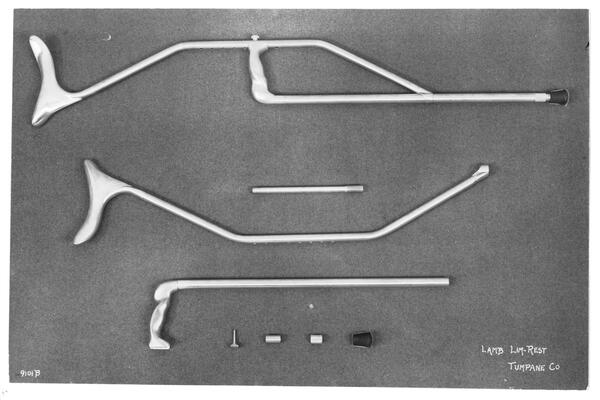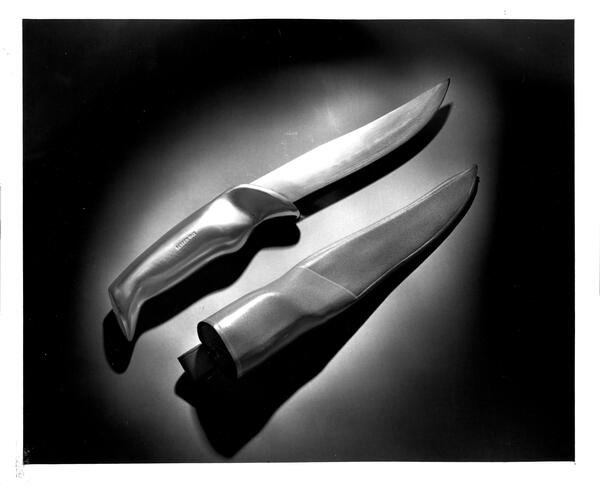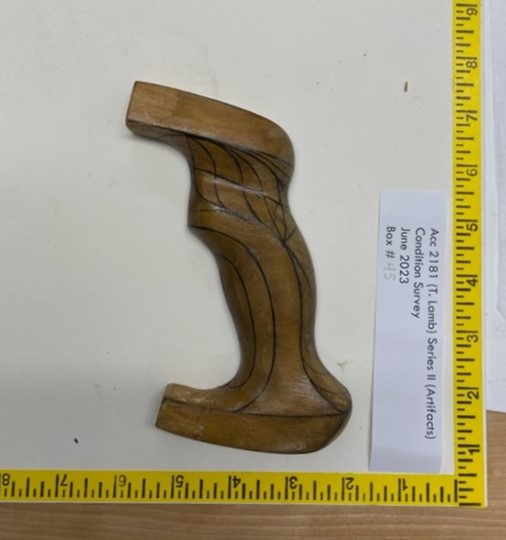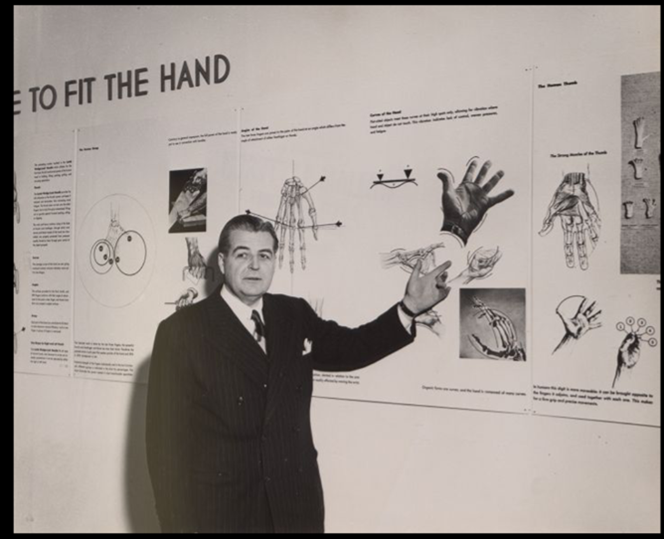As the Hagley Library summer intern in conservation this summer, I was tasked with assessing, conserving, and rehousing some of the the Thomas Lamb collection. Some Hagley collections, including this one, contain objects in addition to papers. Object collections allow researchers to make tangible observations of technological history. Many artifacts are made on the path from an idea to finished product and offer glimpses into the thought processes and decisions of the designers. The sixty-eight boxes of objects in the Thomas Lamb collection paint a picture of meticulously designing and redesigning household items.
Thomas Lamb (1896-1988) grew up in New York City. At a young age, he was interested in art, medicine, and physiology. He spent some of his teenage years studying human anatomy under a surgeon in exchange for drawing anatomical illustrations. He also worked at a textile design studio and studied painting at the Arts Student League. Through the 1920s, Lamb ran a textile studio that made handkerchiefs from designs he hand-painted. He later produced a series of whimsical children’s cartoons and merchandise under the label “Kiddyland.”
 During the Second World War, Lamb shifted gears. After witnessing large numbers of wounded soldiers coming home with injuries and disabilities, Lamb drew upon his anatomical background to develop a more ergonomic crutch, the Lamb Lim-Rest. The Lim-Rest was designed to be ergonomic by putting as little pressure on the muscles of the hand as possible. Lamb studied where body weight falls on crutch users and made slow-motion films of crutch users to study how crutches facilitate or hinder everyday movements and where they concentrate pressure during weight suspension. Lamb would apply these principles to various “Wedge-Lock” handles for cutlery, pots, pans, baggage, and surgical tools. Following maxims of the Universal Design movement, these handles were designed for a broad audience of many sized hands (left and right), took as little force to hold as possible, and were made to enhance comfort.
During the Second World War, Lamb shifted gears. After witnessing large numbers of wounded soldiers coming home with injuries and disabilities, Lamb drew upon his anatomical background to develop a more ergonomic crutch, the Lamb Lim-Rest. The Lim-Rest was designed to be ergonomic by putting as little pressure on the muscles of the hand as possible. Lamb studied where body weight falls on crutch users and made slow-motion films of crutch users to study how crutches facilitate or hinder everyday movements and where they concentrate pressure during weight suspension. Lamb would apply these principles to various “Wedge-Lock” handles for cutlery, pots, pans, baggage, and surgical tools. Following maxims of the Universal Design movement, these handles were designed for a broad audience of many sized hands (left and right), took as little force to hold as possible, and were made to enhance comfort.

Lamb created unassuming, accessible, and utilitarian designs without compromising his aesthetic values. The American Designers’ Institute remarked on his Wedge-Lock Handle, “At first glance, it resembles a piece of abstract sculpture.” This similarity was likely not lost on Lamb. He was deeply engaged in seeing beauty as a key element to the proliferation of industrial manufacturing in the twentieth century. In his 1932 radio lecture “What Is Style,” Lamb declared, “Industrial Art will change most everything we do, use and think. It will not hurt the so called finer arts, such as painting, sculpture, etc., but will tend to bring about a greater appreciation of them and increase their sale.” An Industrial Designer thus can promote beautifying everyday objects to expand profit and the human spirit without compromising utility or appreciation of fine arts. On applying artistry to industry, Lamb emphasized, “not that we are attempting to industrialize Art but to use the forces of Art to beautify the products you buy, increase their function and teach the psychology that Beauty pays Dividends to the industry as a whole.”
 With the belief that money, accessibility, and beauty would all come together for the final product, Lamb produced hundreds of prototype handles before settling on his final designs. The Lamb collection at Hagley offers insight into his path from carving wooden handles to making plaster molds, plaster casts, metal casts, and finally plastic finished products. He often applied clay to his wooden models to understand how different volumes would feel in the hand. Most perplexingly, he drew concentric and overlapping contour lines over wooden and metal models to visualize and emphasize the changing volume along the curves. If his handles look like abstract sculptures in isolation, these marked handles look like the result of their designer trying to emphasize order and geometry with amorphous abstract forms. An ad for his Cutco knife handles claims, “Your hand verifies what your eye has told you… the handle of flowing lines and perfect balance.” Beauty accentuates and reveals industrial order.
With the belief that money, accessibility, and beauty would all come together for the final product, Lamb produced hundreds of prototype handles before settling on his final designs. The Lamb collection at Hagley offers insight into his path from carving wooden handles to making plaster molds, plaster casts, metal casts, and finally plastic finished products. He often applied clay to his wooden models to understand how different volumes would feel in the hand. Most perplexingly, he drew concentric and overlapping contour lines over wooden and metal models to visualize and emphasize the changing volume along the curves. If his handles look like abstract sculptures in isolation, these marked handles look like the result of their designer trying to emphasize order and geometry with amorphous abstract forms. An ad for his Cutco knife handles claims, “Your hand verifies what your eye has told you… the handle of flowing lines and perfect balance.” Beauty accentuates and reveals industrial order.
Going through boxes and boxes of handle models that reached patenting and mass production and were discarded and reworked helped me draw another lesson from Lamb’s practice. Lamb’s success in creating the Wedge-Lock handle came from his recognition that the real tool is the human hand, which the handle simply aims to support. Lamb first studied hand anatomy under the tutelage of a surgeon decades before. He returned to studying the hand later for his Lim-Rest crutches. Lamb understood that fatigue and frustration from using uncomfortable crutches resulted in more injuries and longer healing time. “The result [of poorly designed handles] is unfortunately, that the objects are making the hands perform, rather than the hands making the objects perform.” Lamb’s handles allow the hand to function as it wants to: “A handle might become an extension of the hand proper.”
 The Library Conservation Department at Hagley prioritized the Lamb collection in 2023 because, after over half a century, many of these plastic handles have somewhat degraded. Many factors, such as storage, humidity, and temperature and exposure to UV radiation and acids will determine the rate at which polymers degrade. In the Lamb collection, some handles showed signs of discoloration and deformation that cannot be undone. When considering the principles of accessibility, usability, and beauty Lamb used to design his handles, the degradation seen in some of the collection points to another principle of design: durability. Lamb believed “the path of reconstruction of the world will follow the path of functionalism. Things can be practical and beautiful at the same time.” While conservators and anyone who manages collections storage can help slow plastics degradation, I would add to Lamb’s words that today, things can be practical, durable, sustainable, and beautiful at the same time.
The Library Conservation Department at Hagley prioritized the Lamb collection in 2023 because, after over half a century, many of these plastic handles have somewhat degraded. Many factors, such as storage, humidity, and temperature and exposure to UV radiation and acids will determine the rate at which polymers degrade. In the Lamb collection, some handles showed signs of discoloration and deformation that cannot be undone. When considering the principles of accessibility, usability, and beauty Lamb used to design his handles, the degradation seen in some of the collection points to another principle of design: durability. Lamb believed “the path of reconstruction of the world will follow the path of functionalism. Things can be practical and beautiful at the same time.” While conservators and anyone who manages collections storage can help slow plastics degradation, I would add to Lamb’s words that today, things can be practical, durable, sustainable, and beautiful at the same time.
Eleanor Lieberman is the Conservation Intern at Hagley Museum and Library. She graduated from Harvard College with B.A. in Psychology and the History of Science and is pursuing a career in art conservation.
